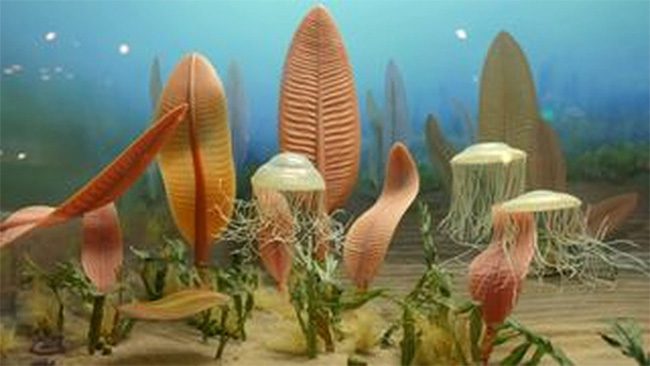About 600 million years ago, the Earth’s magnetic field was disrupted, leading to a global oxidation event that significantly accelerated the process of evolution.
New research on ancient rocks in South Africa and Brazil indicates that the Earth’s magnetic field weakened drastically around 591 million years ago. This period is known as the Ediacaran Period (approximately 635 to 541 million years ago), during which both the atmosphere and oceans became rich in oxygen, allowing organisms to evolve larger sizes and exhibit more movement compared to previous life forms.

Ediacaran marine life model at the Smithsonian Institution, USA (Photo: Ryan Soma).
These findings demonstrate that the weakening of the magnetic field led to increased oxygen activation, resulting in a new evolutionary phase.
The lead researcher, planetary scientist John Tarduno from the University of Rochester, New York, stated, “If this is true, then it is an extraordinarily profound event in the evolutionary process.”
This research may also help us envision how life could flourish on other planets and further illustrates the powerful influence of Earth’s geology on its atmosphere and surface activities.
The Earth’s magnetic field is influenced by movements in the iron-rich core. Today, this magnetic field is generated by the convection of the liquid layer surrounding the core. This liquid layer is affected by heat escaping from the iron core it encases; this heat is produced by the crystallization of the solid core at a rate of about 1 millimeter per year.
However, before the core crystallized and became solid, the Earth had a stimulated magnetic field due to the convection of the liquid core, which generated heat transmitted to the surrounding liquid layer or the mantle. Over time, the core solidified and cooled down, and the temperature difference between the core and the surrounding liquid layer decreased, leading to less heat being released, which in turn reduced the convection and weakened the magnetic field.

Illustration of the Earth’s magnetic field, Earth, solar wind, and particle flow. Research indicates that the magnetic field nearly vanished around 600 million years ago, leading to an era of complex life evolution (Photo: Naeblys/ Getty Images).
This new study suggests that the magnetic field was weakest approximately 591 million years ago, when it was 30 times weaker than it is today. Scientists made this calculation by examining the cooling process of rock crystals formed beneath the Earth’s surface.
Rocks that are 2 billion years old had a magnetic field strength similar to that of today. This indicates that heat transfer from the Earth’s liquid core began to weaken around the time of the Ediacaran Period, and by the onset of the Ediacaran, the magnetic field was already in a state of depletion.
At some point, the magnetic field may have completely vanished, but later, controlling factors for the magnetic field restarted as the Earth’s core began to crystallize, gradually restoring the magnetic field.
The approximately 26 billion years of magnetic field weakening coincides with the Ediacaran oxidation period, and this overlap is likely not coincidental.
The magnetic field surrounds the Earth like a protective blanket, but at the north and south poles, magnetic field lines point directly into space.
As the magnetic field weakens, the open regions around the two poles expand. This opening allows hydrogen molecules to escape into space. Fewer hydrogen molecules mean fewer molecules available for oxygen to bond with, resulting in more free oxygen in the atmosphere and oceans.
This sudden increase in oxygen availability provided an opportunity for organisms to grow larger and become more mobile.
Perhaps Earth was fortunate during that time. If the magnetic field had weakened for too long, the unshielded exposure to space could have caused Earth to lose much of its water.
Planetary scientist Tarduno remarked, “We need the Earth’s magnetic field to preserve water on our planet, but interestingly, during the Ediacaran Period, the magnetic field actually weakened, which helped accelerate the evolutionary process.”





















































